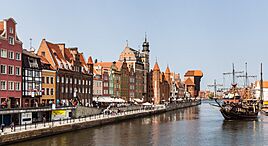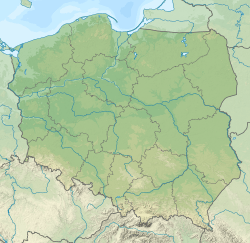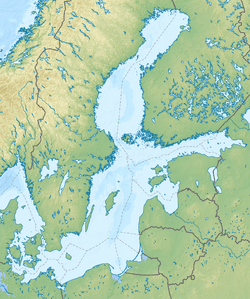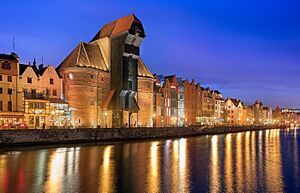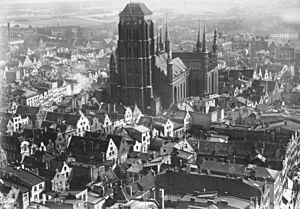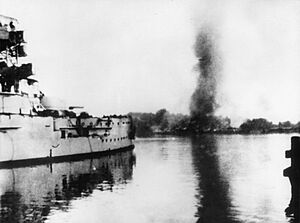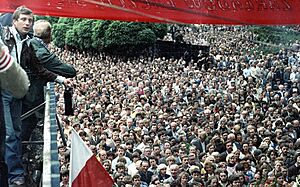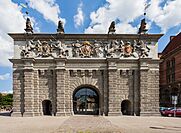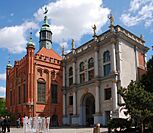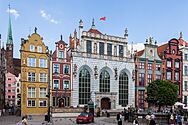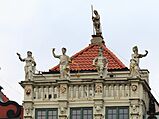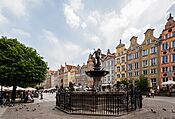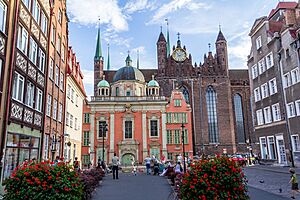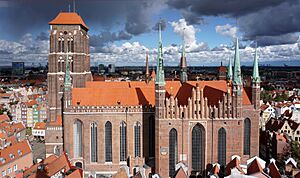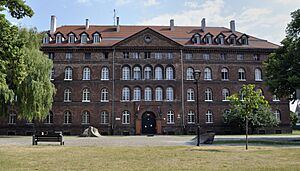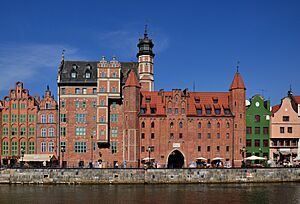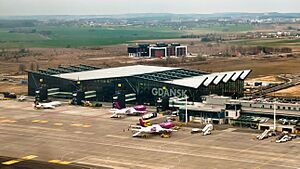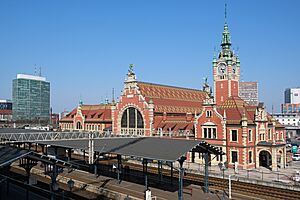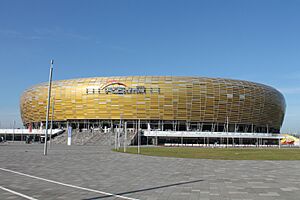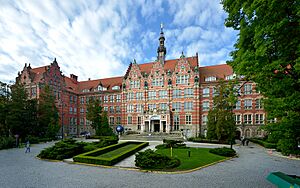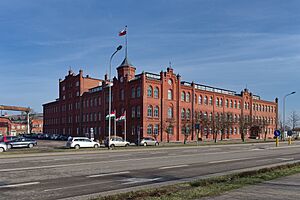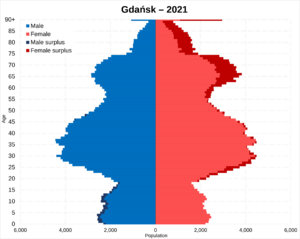Gdańsk facts for kids
Quick facts for kids
Gdańsk
|
|||
|---|---|---|---|
|
Motława River
Artus Court
St. Mary's Church and Main Town Hall
Mannerist Great Armoury
Neptune's Fountain
World War II Museum
Westerplatte Monument
|
|||
|
|||
| Motto(s):
Nec temere, nec timide
(Neither rashly, nor timidly) |
|||
| Country | Poland | ||
| Voivodeship | Pomeranian | ||
| County | city county | ||
| Established | 10th century | ||
| City rights | 1263 | ||
| Government | |||
| • Body | Gdańsk City Council | ||
| Area | |||
| • City | 266 km2 (103 sq mi) | ||
| • Urban | 414.81 km2 (160.16 sq mi) | ||
| Highest elevation | 180 m (590 ft) | ||
| Population
(30 June 2023)
|
|||
| • City | 486,492 (6th) | ||
| • Density | 1,800/km2 (5,000/sq mi) | ||
| • Urban | 749,786 | ||
| • Metro | 1,080,700 | ||
| GDP | |||
| • Urban | €20.529 billion (2020) | ||
| Time zone | UTC+1 (CET) | ||
| • Summer (DST) | UTC+2 (CEST) | ||
| Postal code |
80-008 to 80–958
|
||
| Area code(s) | +48 58 | ||
| Car plates | GD | ||
Gdańsk (pronounced gə-DANSK) is a large city on the Baltic Sea coast in northern Poland. It is the capital of the Pomeranian Voivodeship region. With nearly 500,000 people, it is Poland's sixth-biggest city and a very important seaport. Gdańsk is located where the Motława River meets the Gdańsk Bay. It is close to the city of Gdynia and the resort town of Sopot. Together, these three places form a big city area called the Tricity, home to about 1.5 million people.
Gdańsk has a long and interesting history. It has been ruled by Poland, Germany, and even had periods of self-rule. Since the Middle Ages, it has been a major shipbuilding and trading port. In 1361, it joined the Hanseatic League, a powerful group of trading cities. This greatly shaped its economy and city design. For a long time, from the 15th to 17th centuries, it was the largest city in Poland and its main seaport.
In 1793, Gdańsk became part of Prussia, and later the German Empire in 1871. After World War I, it became a special "Free City" from 1920 to 1939. This meant it was independent but protected by the League of Nations, with Poland having some control over its foreign affairs. On September 1, 1939, Gdańsk was where World War II began, with the Battle of Westerplatte.
After 1945, the city changed a lot. Many people moved in and out, and the city was rebuilt. In the 1980s, Gdańsk became famous as the starting point of the Solidarity movement. This movement helped bring down the communist governments in Eastern Europe.
Today, Gdańsk is home to important universities, museums like the Museum of the Second World War, and the European Solidarity Centre. Famous landmarks include the Town Hall, Artus Court, Neptune's Fountain, and St. Mary's Church, which is one of the biggest brick churches in the world. The city's airport, Gdańsk Lech Wałęsa Airport, is very busy. Gdańsk is a popular place for tourists, and it hosts the St. Dominic's Fair, a huge trade and cultural event that started in 1260.
Contents
Understanding the City's Names
How Gdańsk Got Its Name
The name Gdańsk likely comes from the Gdania river, which is now called the Motława River. The city is built on this river. Some language experts also think the name comes from an old Slavic word, gъd-, meaning 'wet' or 'moist'.
A Look at Historical Names
The city's name has changed a bit over time. In 997 CE, it was called urbs Gyddanyzc. Later, it was written as Kdanzk in 1148, and Gdańsk in 1236. The German name, Danzig, developed later. It made the sounds easier for German speakers to say.
In Polish, the city's name is pronounced with a special 'n' sound. In English, people usually say gə-DANSK. The German name, Danzig, is pronounced differently. These different names show how hard it can be to say Polish words for people who speak other languages.
Special Names for Gdańsk
Sometimes, on important occasions, Gdańsk is called "The Royal Polish City of Gdańsk." This name highlights its long history as a royal city in Poland. In the Kashubian language, a local language, the city is called Gduńsk.
Gdańsk Through Time
Early Settlements and Beginnings
People have lived in the area of Gdańsk since the Bronze Age, around 2500–1700 BCE. The settlement that grew into Gdańsk started in the 9th century. It was mostly a village where people farmed and fished. By the early 10th century, it became an important trading spot. Around 975, it became part of Poland under Mieszko I.
The first written mention of Gdańsk is from 999. It talks about Adalbert of Prague baptizing people in urbs Gyddannyzc in 997. This place was described as separating Poland from the sea. Because of this record, the city celebrated its 1000th birthday in 1997.
After World War II, much of the city was destroyed. This allowed archaeologists to dig and find old remains. They found 17 layers of settlements dating from 980 to 1308. Mieszko I of Poland built a stronghold here in the 980s. This connected the early Polish state with the Baltic Sea trade routes.
A Growing City in Pomerania
The area was ruled by local dukes called the Samborides. The city included a market, craft settlements, and a German merchant area. In 1215, it became the center of a smaller duchy. In 1263, Duke Swietopelk II gave Gdańsk city rights, similar to those in Lübeck, Germany. This helped the city grow.
By 1300, about 2,000 people lived in Gdańsk. It was not a huge trade center yet, but it was important for trade with Eastern Europe. The local dukes sometimes had financial problems. They even lent the city to Brandenburg, a German state, but planned to give it back to Poland. Danish princes took the city in 1301.
The Time of the Teutonic Knights
In 1308, the Brandenburgians and the Teutonic Knights took over Gdańsk. The Knights then gained control. Historical records mention a difficult event in 1308, where the Teutonic Knights caused harm to the local people. While the exact number is debated, it was a significant event that Poland used to argue against the Knights.
The Knights brought German settlers to the area. In 1340, they built a large fortress. In 1358, Gdańsk joined the Hanseatic League, a powerful trading group. This helped the city connect with other major trade centers like Bruges and Novgorod. By 1377, the Old Town also received city rights. A "New Town" was founded in 1380.
Gdańsk became very important for trade, especially for sending grain, timber, and other goods from Poland down the Vistula River. Even though the Teutonic Knights tried to limit its economic power, the city thrived. German migration increased during this time. In 1409, a war broke out between Poland and the Teutonic Knights. Gdańsk came under Polish control for a year after the Battle of Grunwald in 1410, but then returned to the Knights.
Gdańsk as Part of Poland
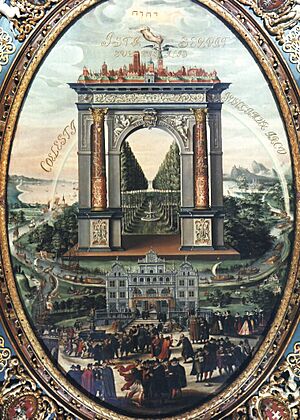
In 1440, Gdańsk helped create the Prussian Confederation. This group was against the Teutonic Knights' rule. They complained that the Knights often treated local leaders unfairly. In 1454, King Casimir IV of Poland took the area back into the Kingdom of Poland. This led to the Thirteen Years' War (1454–1466) between Poland and the Teutonic Knights.
From 1454, the city was allowed to make its own Polish coins. In 1457, King Casimir IV gave Gdańsk the Great Privilege. This gave the city full self-rule and protection from the Polish King. It removed trade taxes within Poland, Lithuania, and Ukraine. It also gave Gdańsk its own courts and the right to make its own money. This privilege also united the different parts of the city.
With free access to Polish markets, Gdańsk's port grew rich. It also traded with other Hanseatic cities. After the war ended in 1466, Gdańsk became part of the Polish province of Royal Prussia. The famous scientist Nicolaus Copernicus visited Gdańsk in 1504 and 1526. His first printed summary of his sun-centered theory was published there in 1540. Gdańsk kept a lot of its self-rule and was one of the most important cities in Poland.
In the 1560s and 1570s, a large Mennonite community grew in the city. In 1575, Gdańsk supported Maximilian II for the Polish throne, but Stephen Báthory became king. Gdańsk closed its gates to him. After a six-month siege, the city's army was defeated. However, the king could not take the city by force. So, they made a deal: Stephen Báthory confirmed Gdańsk's special rights, and the city recognized him as king and paid a large sum of money.
During the Polish–Swedish War in 1627, the Polish Navy won a big victory near Gdańsk in the Battle of Oliwa. The city was also besieged by Sweden during the Swedish invasion of 1655–1660, but it was not captured. The war ended in 1660 with a treaty signed in the Oliwa district.
Around 1640, Johannes Hevelius built his astronomical observatory in the Old Town. Polish King John III Sobieski visited him many times. Gdańsk was home to people speaking German, Polish, and other languages. Many German-speaking people became Lutherans. Because of its special status, the people of Gdańsk often shared both Polish and German cultures. They were very loyal to the Polish-Lithuanian Commonwealth.
The city faced a slow economic decline in the 18th century due to wars. After peace returned in 1721, Gdańsk's economy improved. In 1734, it was captured by the Russians during the War of the Polish Succession. By the 1740s, Gdańsk's port was again the most important for exporting grain in the Baltic region.
In 1772, Poland was divided by its neighbors. Prussia took most of the region, but Gdańsk remained part of Poland. The Prussian king tried to hurt Gdańsk's trade by blocking shipping. This caused Gdańsk to lose some of its economic importance. Still, by the end of the 18th century, Gdańsk was one of the most connected cities in Poland.
Under Prussian and German Rule
In 1793, Gdańsk was taken by Prussia during the Second Partition of Poland. Many Polish and German-speaking people in the city did not want this to happen. They wanted Gdańsk to stay part of Poland. The city's mayor and a famous city councilor, Jan Uphagen, resigned to protest. Uphagen's house is now a museum.
During the Napoleonic Wars, in 1807, French and Polish forces captured the city. It became a free city from 1807 to 1814. Then, Prussian and Russian forces captured it, and in 1815, it became part of Prussia again. It was the capital of the Danzig region within the province of West Prussia.
From the 1820s, the Wisłoujście Fortress was used as a prison for Polish political prisoners. Many Poles who were fighting for independence were held there. In the 1830s, over 1,000 Polish freedom fighters left partitioned Poland through Gdańsk's port. They sailed to France, the United Kingdom, and the United States.
In 1871, Germany became a united country, and Gdańsk became part of the German Empire. It remained so until 1919, after Germany lost World War I.
The Free City and World War II
After World War I, Poland became independent again. The Allies promised Poland access to the sea. Poles hoped Gdańsk would become part of Poland. However, most people in the city were German. So, the Treaty of Versailles made Gdańsk a Free City. It was independent but overseen by the League of Nations. Poland had some control over its foreign affairs, including free use of the harbor and a Polish post office. The Free City had its own government, parliament, and money.
In the 1930s, Nazism grew among Germans in Gdańsk. Feelings against Poles increased. The rights of Poles in the city were often limited. Polish children were sometimes not allowed into public Polish-language schools. Attacks happened on Polish schools and youth groups. Polish symbols were removed from city landmarks.
From 1937, German companies were not allowed to hire Poles, and Poles already working were fired. Speaking Polish in public places was banned. In 1939, before World War II started, Polish railway workers were treated badly. After the invasion, they were arrested and killed.
Adolf Hitler wanted Gdańsk to return to Germany. He also wanted a special highway through the Polish Corridor to connect Germany. Hitler used Gdańsk as an excuse to attack Poland. He told his military leaders that the real goal was to expand German territory in the east.
Germany attacked Poland on September 1, 1939. The attack began in Gdańsk. The German battleship Schleswig-Holstein bombed Polish positions at Westerplatte. Polish defenders at Westerplatte fought for seven days. Meanwhile, Polish postal workers bravely defended the Polish Post Office for a day. They were later executed. The city was officially taken by Nazi Germany.
Many Jewish people had already left Gdańsk after a difficult event in 1937. By September 1939, only about 1,700 mostly older Jewish people remained. Most of them were later killed in the Holocaust.
Nazi secret police had lists of Poles to arrest. On the first day of the war, about 1,500 ethnic Poles were arrested. Many were sent to the Stutthof concentration camp and killed. During the war, Germany ran several camps and prisons in the city.
In 1945, as the Soviet Army advanced, many German refugees came to Gdańsk. They tried to escape by ship from the city's port. Some ships were sunk by the Soviets, and many refugees died. The Soviet Army captured the heavily damaged city on March 30, 1945.
After the war, the Allies decided that Gdańsk would become part of Poland again. The remaining German residents left or were sent to postwar Germany. Polish people from other parts of Poland moved into the city.
Life After World War II (1945-1989)
In 1946, the communist government executed two Polish resistance members, Danuta Siedzikówna and Feliks Selmanowicz, in the local prison.
Gdańsk's port was important for refugees. In 1949, Greek and Macedonian refugees from the Greek Civil War arrived in Gdańsk. From there, they were taken to new homes in Poland.
Much of Gdańsk's historic old city was destroyed during the war. It was rebuilt in the 1950s and 1960s. The goal was to make the city look more Polish and less German. Older buildings from the 19th century were often removed.
Gdańsk became a major shipping and industrial center for communist Poland. This was thanks to big investments in its port and shipyards. In December 1970, Gdańsk was the site of anti-government protests. Police and military forces fired on demonstrators, causing many deaths.
Ten years later, in August 1980, the Gdańsk Shipyard became the birthplace of the Solidarity trade union movement. This movement was against the communist government. In September 1981, the Soviet Union held a huge military exercise near Gdańsk to try and scare Solidarity. But Solidarity kept growing. Its fight against the communist regime led to the end of communist rule in Poland in 1989. This also helped inspire other protests that brought down communist governments across Eastern Europe.
Gdańsk Today (1990-Present)
Solidarity leader, Lech Wałęsa, became President of Poland in 1990. In 2014, the European Solidarity Centre opened in Gdańsk. It is a museum and library about the history of the Solidarity movement.
In 2001, the city experienced a big flood. As a result, Gdańsk has built many water reservoirs to prevent future floods.
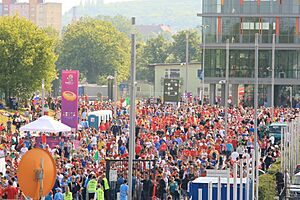
Donald Tusk, who is from Gdańsk, served as Prime Minister of Poland and later as President of the European Council. In 2016, the remains of Danuta Siedzikówna and Feliks Selmanowicz, the resistance members executed in 1946, were found and given a state burial in Gdańsk.
In 2019, Gdańsk received the Princess of Asturias Award for Concord. This award recognized the city's history of solidarity, defending freedom, human rights, and working for peace. In a 2023 report, Gdańsk was named one of the top four cities in Europe for quality of life.
Geography and Climate
Where is Gdańsk Located?
Gdańsk is located where the Motława River flows into the Martwa Wisła, which is a branch of the Vistula River. The city is on the edge of several natural areas. These include the Vistula Spit (the part of the city near the water), the Vistula Fens (the eastern part), and the Kashubian Coastland and Kashubian Lake District (the western parts).
Understanding Gdańsk's Weather
Gdańsk has a climate that is a mix of oceanic and continental influences. This means it gets some effects from the nearby sea and some from the larger landmass. Winters are usually moderately cold and cloudy. Summers are mild with frequent rain and thunderstorms.
Average temperatures range from about -1°C (30°F) in winter to 17.2°C (63°F) in summer. The city gets about 507.3 mm (20 inches) of rain each year. The weather is generally damp, changeable, and mild.
The seasons are clear. Spring starts in March, bringing warmer, sunnier weather. Summer begins in June and is mostly warm, sometimes hot, with lots of sunshine and heavy rain. July and August are the warmest months. Autumn starts in September, bringing warm, sunny days that turn cold and foggy by November. Winter lasts from December to March, with periods of snow. January and February are the coldest months.
Economy and Industry
Key Industries in Gdańsk
Gdańsk's economy is strong in several areas. Shipbuilding, petrochemicals (products from oil and gas), and chemical industries are very important. Food processing is also a big part of the local economy.
Newer, high-tech industries are growing fast. These include electronics, telecommunications, IT engineering, cosmetics, and pharmaceuticals. Amber processing is also a major industry. This is because most of the world's amber is found along the Baltic Sea coast.
Major Companies and Trade
Many big companies are based in Gdańsk. These include the clothing company LPP, Energa (an energy company), Remontowa (a shipbuilding company), the Gdańsk Shipyard, and Ziaja (a cosmetics company). The city was also a main base for Grupa Lotos, which had Poland's second-largest oil refinery.
Gdańsk hosts the BALTEXPO International Maritime Fair and Conference every two years. This is the biggest event in Poland for the maritime industry. The largest shopping center in the city is Forum Gdańsk. In 2021, the unemployment rate in Gdańsk was about 3.6%, which is quite low.
Exploring Gdańsk's Main Sights
Beautiful Architecture and Royal Route
Gdańsk has many old buildings from the time of the Hanseatic League. Most tourist spots are in the Main City area. They are along or near Ulica Długa (Long Street) and Długi Targ (Long Market). This area is a pedestrian street with buildings rebuilt in old styles. It is called the Royal Route because Polish Kings used to walk here in parades.
As you walk along the Royal Route, you will see:
- Highland Gate (Brama Wyżynna): This marks the start of the Royal Route.
- Torture House (Katownia) and Prison Tower (Wieża więzienna): These now house the Amber Museum.
- Mansion of the Society of Saint George (Dwór Bractwa św. Jerzego).
- Golden Gate (Złota Brama).
- Ulica Długa ("Long Lane"): This street is full of charming old houses.
- Uphagen's House (Dom Uphagena): A museum that is part of the Museum of Gdańsk.
- Lion's Castle (Lwi Zamek).
- Main Town Hall (Ratusz Głównego Miasta): Built between 1378 and 1492.
- Długi Targ ("Long Market"):
- Artus' Court (Dwór Artusa).
- Neptune's Fountain (Fontanna Neptuna): A beautiful fountain from 1617. It is the oldest working fountain in Poland.
- New Jury House (Nowy Dom Ławy): Here, a "Maiden in the Window" appears daily during tourist season. This refers to a popular novel.
- Golden House (Złota Kamienica): A unique Renaissance house from the early 17th century with many sculptures.
- Green Gate (Zielona Brama): A gate built as a formal home for Polish kings. It now holds a part of the National Museum.
- Olivia Business Centre: A modern district with six buildings.
- Olivia Star: The tallest building in Gdańsk and northern Poland, finished in 2018. It is 156 meters (512 feet) tall.
Gdańsk has many historic churches, like St. Catherine's Church and St. Mary's Church (Bazylika Mariacka). St. Mary's Church is one of the largest brick churches in the world. The city's 17th-century walls are an official national monument of Poland.
Other important sights in the old city center include:
- Royal Chapel of the Polish King John III Sobieski.
- Żuraw – a medieval port crane.
- Granaries on the Ołowianka and Granary Islands.
- John III Sobieski Monument.
- Old Town Hall.
- Mariacka Street.
- Polish Post Office, famous for the 1939 battle.
- Brick gothic town gates, like Mariacka Gate and Golden Gate.
Main sights outside the historical city center include:
- Abbot's Palace in the Oliwa Park.
- Oliwa Cathedral.
- Brzeźno Pier.
- Medieval city walls.
- Westerplatte.
- Wisłoujście Fortress.
- Gdańsk Zoo.
Museums to Explore
Gdańsk has many museums where you can learn about its history and art:
- National Museum (Muzeum Narodowe):
- Department of Ancient Art: Has important artworks, like Hans Memling's Last Judgement.
- Green Gate: A branch of the museum.
- Historical Museum (Muzeum Historyczne Miasta Gdańska):
- Main Town Hall.
- Artus' Court.
- Uphagen's House.
- Amber Museum (Muzeum Bursztynu).
- Museum of the Polish Post (Muzeum Poczty Polskiej).
- Wartownia nr 1 na Westerplatte.
- Museum of Tower Clocks (Muzeum Zegarów Wieżowych).
- Wisłoujście Fortress.
- National Maritime Museum, Gdańsk (Narodowe Muzeum Morskie):
- The museum ship SS Sołdek is anchored on the Motława River. It was the first ship built in Poland after World War II.
- European Solidarity Centre: A museum and library about the Solidarity movement.
- Archdiocese Museum (Muzeum Archidiecezjalne).
- Museum of the Second World War.
Entertainment and Culture
Gdańsk offers many cultural experiences:
- Polish Baltic Philharmonic.
- Baltic Opera.
- Gdańsk Shakespeare Theatre: This theater is built where a 17th-century playhouse once stood. English actors used to perform here. The new theater, finished in 2014, hosts the yearly Gdańsk Shakespeare Festival.
Transportation in Gdańsk
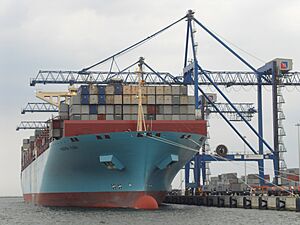
Gdańsk has a strong transportation system. It includes the Gdańsk Lech Wałęsa Airport, which is an international airport. The Szybka Kolej Miejska (SKM) is a fast train system for the Tricity area (Gdańsk, Sopot, and Gdynia). It has frequent trains to 27 stations.
The main train station in Gdańsk is Gdańsk Główny railway station. Both local SKM trains and long-distance PKP trains use it. Long-distance trains also stop at other stations like Gdańsk Oliwa and Gdańsk Wrzeszcz. Gdańsk has nine other local train stations. Long-distance trains connect Gdańsk with all major Polish cities, like Warsaw and Kraków.
Between 2011 and 2015, the train route between Gdańsk, Gdynia, and Warsaw was greatly improved. This made train travel faster. A new suburban railway, the Pomorska Kolej Metropolitalna, opened in 2015.
City buses and trams are run by ZTM Gdańsk. The Port of Gdańsk is a major seaport. Highways like the Obwodnica Trójmiejska and A1 autostrada provide good road access to the city. Gdańsk is also part of the Rail-2-Sea project. This project aims to connect Gdańsk by a long railway line to Constanța, a port on the Black Sea in Romania.
Sports in Gdańsk
Gdańsk and the Tricity area have many popular professional sports teams. The city's main football (soccer) club is Lechia Gdańsk. Founded in 1945, they play in Poland's top league, the Ekstraklasa. Their home stadium, Stadion Miejski, hosted games for the UEFA Euro 2012 football championship. It also hosted the 2021 UEFA Europa League Final. Other football clubs include Gedania 1922 Gdańsk and SKS Stoczniowiec Gdańsk.
Other notable sports clubs include the speedway club Wybrzeże Gdańsk, the rugby club Lechia Gdańsk, the ice hockey club Stoczniowiec Gdańsk, and the volleyball club Trefl Gdańsk.
The city's Hala Olivia hosted the 2009 EuroBasket basketball tournament. The Ergo Arena was a venue for the 2013 Men's European Volleyball Championship, the 2014 FIVB Volleyball Men's World Championship, and the 2014 IAAF World Indoor Championships.
Education and Science
Gdańsk has 15 higher education schools, including three universities. Important schools include the University of Gdańsk, Gdańsk University of Technology, and Gdańsk Medical University. The city is also home to the Baltic Institute.
International Connections
Consulates in Gdańsk
Gdańsk hosts several consulates. These include four consulates general from China, Germany, Hungary, and Russia. There is also one consulate from Ukraine. Additionally, 17 countries have honorary consulates in Gdańsk, including Austria, Mexico, Spain, and Sweden.
Sister Cities Around the World
Gdańsk is connected with many cities around the world as "sister cities":
Gdańsk used to be twinned with Kaliningrad and Saint Petersburg in Russia. However, on March 3, 2022, the Gdańsk City Council decided to end cooperation with these Russian cities. This was in response to the Russian invasion of Ukraine.
Gdańsk also works with other cities in partnerships:
Population and People
In 1923, a survey in the Free City of Danzig showed that about 95% of people were German, and 3% were Polish or Kashubian. After World War II, the population of Gdańsk changed a lot.
Polish people from other parts of Poland moved to Gdańsk. The first settlers arrived in March 1945. By November 1945, about 93,029 Germans still lived in the city. Germans who said they were Polish were allowed to stay.
The new settlers came from different backgrounds:
- Poles who had been forced to work in Nazi Germany.
- Poles who were moved from eastern Polish areas taken by the Soviet Union.
- Poles, including Kashubians, who moved from nearby villages.
- People who moved voluntarily from central Poland.
- Non-Poles who were forced to move during "Operation Vistula" in 1947. This included many Ukrainians and Belarusians. The Polish government wanted to spread out these groups to help them fit in.
- Jewish people who survived the Holocaust, many of whom were Poles returning from Soviet areas.
- Greeks and Slav Macedonians who were refugees from the Greek Civil War.
Famous People from Gdańsk
You can find a list of famous people from Gdańsk in the article: List of people from Gdańsk.
See also
 In Spanish: Gdansk para niños
In Spanish: Gdansk para niños


